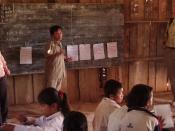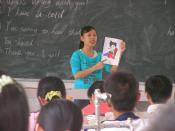It is up to the teacher to create the culturally, responsive, inclusive classroom. This is done by the teacher paying attention to the different backgrounds among his/her students and to have these differences reflected in a meaningful way to the child. It will make it easier for the students to learn if consideration is made towards their culture. "This recognition gives students a positive feeling about their worth as individuals and as production members in their classroom" (Martin, Ashelman, and Searson 213). The culture of the child is the foundation for all past and future learning to that child. This is because of the language that is used through the every day activities, such as speaking. Many different theorists believe language is the foundation for all learning, including literacy. Vygotsky thought that children learned through their exposure to language with adults, such as concrete experiences and simultaneous experiences. This is similar to Bruner's theories that you can apply all children's oral language to literacy instruction (Cramer 67-8).
Thus, if language and culture is accepted into your classroom it will make teaching literacy easier as a whole. That is because literacy is reading, writing, speaking, listening, viewing and visually representing (Cramer 6).
There are many different things that you need to do to accomplish this. As a teacher you need to assess your own knowledge of the different cultures that are in your classroom. This will lead to broadening your horizons on situations, languages and other differences to you. Similarly, there are assignments that can be done to enhance the knowledge of the students in the class. This can be accomplished with interdisciplinary units, journal writing, multicultural books and open ended projects (Martin, Ashelman, and Searson 212-3). The goal is to make everyone feel comfortable with their own culture as well...


